Königsberger Klopse
Königsberger Klopse. Allegedly, the Königsberger Klops is the best-known regional dish in German cuisine – and yet its home region of East Prussia has not been a part of Germany for a long time. Königsberg (Kaliningrad) is a seven-hour drive from the nearest German border. The aroma of the Königsberger Klopse is characterized by an anchovy-caper-lemon flavor combination that is not typical for Germany. And not one of the ingredients is found in Germany.


It is a dish that seems to be everywhere in Germany and that has been found in various cookbooks from all German regions since the 19th century – and about which there is hardly any information. The dumplings are made from minced meat – the mixed version of pork and beef is usually used. Anchovies, eggs, and bread or breadcrumbs are also a part of the dough. The anchovy passes on its own flavor. The dumplings are boiled, and the cooking water/broth serves as the basis for a creamy roux, white wine, cream, lemon, and bay leaf sauce, to which capers are added shortly before serving.
There are also classic potatoes and beetroot. In terms of basic preparation, the recipes across regions and decades are unanimous. Recipes that omit the anchovies or completely withhold the fact that it should actually be minced veal can be ignored. The originally poorer variant, in which the anchovies were replaced by herrings, is steeped in tradition but is a step backward in terms of taste. By the 19th century at the latest, “Preußischen Klöpse“, “Danziger Klöpse”, “Klöpse mit Sardellen”, Sauren Klöpse” (Prussian dumplings, Danziger dumplings, dumplings with anchovies and sour dumplings) can be found in cookbooks across Germany.



